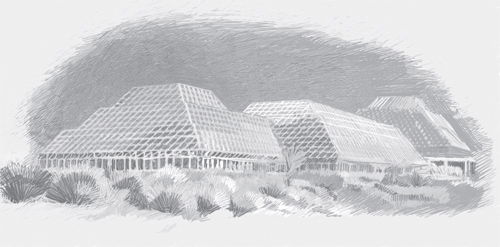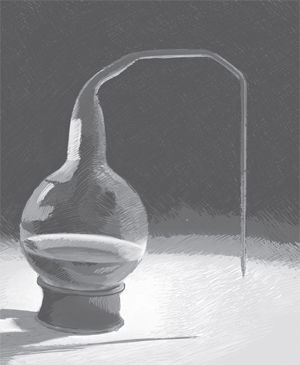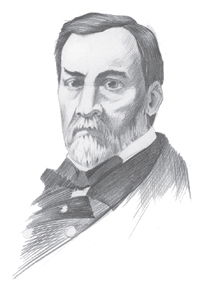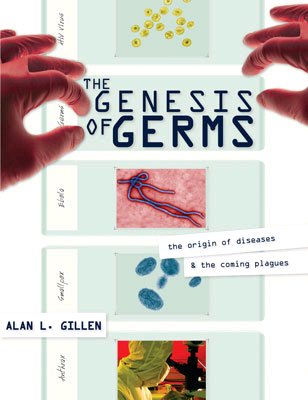Chapter 1
Microbes by Design
Section 1

The news media writes frequently about the evolution of new microbe strains that can cause disease. New diseases such as hemolytic uremic syndrome caused by E. coli, flesh-eating Streptococcus, methicillin-resistant Staphylococcus aureus (MRSA), antibiotic-resistant malaria, and bird flu all capture the national headlines. With each passing year, news headlines reveal that some new disease outbreak or plague has “evolved” and it threatens thousands of lives. In the year 2005, the news flash “Bird Flu Threatens Globe” was broadcast across the nation, leading many people to become alarmed. The emergence of a new strain (H5N1) of flu may place millions at risk.
Another one of these prevalent and menacing diseases is MRSA, which is a new strain of Staphylococcus aureus; it is resistant to methicillin and therefore becomes very difficult to treat. Consequently, it becomes a huge nuisance and ailment to the one infected. The pace of the development of antibiotic resistance to emerging, incurable infections is faster than drug makers can keep up with and treat.
Are these examples of evolution? Are these facts of evolution? Did God make microbes by mistake? Are they accidents of evolution, out of the primordial soup? These timely questions are examined throughout this book.
First, these news headlines of bird flu and antibiotic resistance are not examples of Darwinian evolution. On the contrary, they are examples of variation, or change within “kinds.” Later in the book we will explore how and why these examples of minor changes (variations within kind) in microbes can cause disease. Second, microbes are not the Creator’s mistake, nor are they random accidents of evolution. Not only were microbes originally created for our good (and the biosphere’s), but their design also shows creativity, diversity, intelligence, and beauty. A few microbes (five percent of the bacteria) reflect decay and degeneration from the original plan. Disease was not the Creator’s original plan, but rather a reflection of man’s sin, the Curse placed on nature.
The Power Unseen
Microorganisms—this term is not new to the average person. These “animicules,” “cavorting and wee beasties,” and “minute eels,” as Leeuwenhoek called them, are creatures of the unseen world. They may be introduced as harmless, beneficial, or even harmful bugs. No matter how efficient or awe-inspiring the presentation about microbes is, each person views them in a different way. Maybe you were not interested in microbiology and figured it was another subject no more significant than others. However, microbes are powerfully influencing our lives whether we acknowledge it or not. The purpose of this book is to show how life and microbes are inseparable. The microbial world is both surprising and stunning. It is surprising because it contains a wealth of diversity of life forms. The microbial world is also stunning because we rarely understand how these microbes affect our own world, and we also overlook the elegance of their design.
Bacteria are found throughout the earth, from the equator to the poles, and are presently the most common type of microorganism. It may be difficult to believe that creatures so minute can be so dynamic. They are surrounding us even as we speak. They are in our water, milk, yogurt, cheese, bread, and other foods. We never really realize their importance until something goes wrong with us. We get sick, and then we want to know something about the “bug.” We want to take the first pill or antibiotic in sight to cure our sickness.
Fungi, protozoans, and viruses, like bacteria, make up the unseen world. They are also a part of our everyday life. We use yeasts in our daily bread. Protozoans are in our pond and aquarium water. Viruses are now responsible for a new and widely publicized epidemic, the bird flu. However, microorganisms also are inseparable from our world, and should be seen as relevant to our life. What would this world be like without the unseen? This book is designed to make the educated layperson and student aware of the unseen world of microbes. It also brings a creation and biblical perspective to microbiology. This book should challenge you to think of the unseen as relevant to your world and make you aware of the wondrous design in microbes given by the Creator.
Book Objectives
The objectives of this book are to
- Describe the designed structures and purposeful functions for each of the microbial systems;
- Explain selective in-depth explorations for specific creative design components in bacteria, fungi, and protozoans;
- Explain the origin of disease from a creation, biblical perspective;
- Provide examples of microbiologists who have held a creation or intelligent design perspective.
What Is a Microbe?
The term microbe was first used in 1878 to describe “extremely minute living beings.” At that time, this definition was chiefly applied to one major category of microbes, the bacteria. Before 1878, scientists, including Louis Pasteur, used a variety of terms (examples: animalcules, infusoires, and germs) rather loosely to label the very small organisms that had interested them. It was not clear whether microbes belonged to the animal or plant kingdoms or to a completely different one. Early biologists also did not fully realize the extent of life on earth as we know it today. Visible effects of microbes on higher plants and animals, however, were commonplace and evident long before the existence of microbes was discovered in the 17th century. They were particularly obvious when the effects were deleterious, such as from an infectious disease, and were sometimes viewed as super-natural events or mysterious, “spontaneous” phenomena. Logical explanations of infectious disease and other manifestations of microbial life had to wait on two developments: the acceptance of the concept that invisible microbes existed and the tangible evidence of their reality. Several creation scientists, including Anton Leeuwenhoek, Robert Hooke, Louis Pasteur, and Joseph Lister, would play a role in developing the notion of their reality and in proving that those germs cause disease.
In the earliest observations of bacteria, fungi, and protozoans, infusorium was the most common term used for these creatures. This is because the first cultures of microscopic organisms were made with infusions, which consisted of water with added hay, straw, and soil. In 1879, a French scientist, Charles E. Sedillot, gave the term microbe. It included any living thing that must be magnified by a microscope. Traditionally, microbes have been described as free-living organisms that are so small (less than about 100 micrometers [µm]) that they are visible only under the microscope; however, a few microbes are large enough to be seen with the naked eye. The smallest bacteria are barely 0.2 µm long, but giant bacteria and protozoa can be 1 millimeter (mm) in length or even longer. Microbes are either prokaryotes (cells lacking a true nucleus), or eukaryotes (cells with a true nucleus). Eukaryotic microbes, other than algae and fungi, are collectively called protists. These include protozoans and slime molds. A complicating factor is that some microbes are especially hard to define, partly because they have large relatives. For example, yeasts are certainly microbes, but mushrooms are not—yet both are fungi.
How Small Are Microbes?
Microbes are very small. The volume of a typical bacterium is only about 1 µm3, roughly 1/1,000 that of human cells, such as cheek cells. However, there is a large range in size among bacteria; this illustrates that the Creator loves variety. Some species are considerably larger, while others are smaller than the average. One gargantuan species (Epulopiscium fishelsoni) that lives in the intestine of the surgeonfish is huge! It is over 0.5 mm in length and is visible to the naked eye. It is about three times bigger than Paramecium. The range in volume of the smallest to the largest known bacteria is well over one million-fold. Therefore, size is not always a good way to distinguish prokaryotes from eukaryotes. In addition, some marine algae are about 1 µm in diameter; they are the smallest known eukaryotes, well within the range of most prokaryotes. However, it is generally true that most prokaryotes are smaller than eukaryotic cells.
Why Microbes Matter
So why should we study microbiology? New and updated information about microbiology is continuously shaping our lives, especially concerning our society’s healthcare. It helps us understand infectious diseases and the best ways to cure them. Microbes benefit our lives in the environment and provide the basis for many of our fermented foods. It also tells us about the Creator’s handiwork; His intricate design extended down to the smallest creatures in our world. The icon for the intelligent design movement is the bacterial flagella. Furthermore, they help us recognize and understand various principles in the Bible.
Are Microbes the Creator’s Mistakes?
Microbes have been designed as tiny, intricate machines that manufacture foods, vitamins, and essential materials for sustaining life. They are the Creator’s provision for recycling valuable nutrients and making useful products for man. The news media publishes many articles about microbes that cause disease, but only a few discuss their usefulness. Many students have the impression that microbes are harmful and fear their hands-on study. We call this attitude microbe-phobia, or a fear of microbes. In reality, only about five percent of all bacteria are pathogenic. Most bacteria are beneficial and some are even essential for human life. Many microbiologists maintain that bacteria and other microbes have been maligned in the news media. Bacteria make products that are used every day; many foods, like yogurt, are created by microbe action. Barely a day goes by without using some of these products.
Without our intestinal flora, we would not survive very well. In fact, if intestinal microbes are not present early in our lives, the surface of the intestine does not develop normally. The surface would remain smooth rather than developing the carpet of projections called microvilli. We would have to adjust to living with a vastly reduced ability to absorb water and nutrients. Enteric bacteria supply our bodies with vitamin K, vitamin B12, thiamin, and riboflavin, which we need for normal body functioning. These intestinal microflora bacteria also stimulate lymph node-like structures, called Peyer’s patches, which contain lymphatic tissue and provide the intestines with protection, even helping to prevent colon cancer. They maintain an intensely competitive and closed community, which makes invasion from pathogens a considerable challenge.
According to Dr. Jay Wile, additional evidence that microbes are not the Creator’s mistake comes from a large experiment called “Biosphere 2.” A team of scientists tried to design and build a self-contained system (i.e., Biosphere 2) for supporting life. Biosphere 2 was designed to be a microcosm of life on earth, containing a variety of animals and plants; it was to be completely self-supporting. These biologists spent seven years and $200 million designing and building this airtight, enclosed facility that spans 3.15 acres in Arizona. Despite the best that technology and science had to offer, Biosphere 2 could not support life for even two years! After about one year and four months, oxygen levels could not be maintained. They had to start pumping oxygen in from the outside. Many of the animal species that had been put in Biosphere 2 became extinct, while the populations of others boomed. In the end, Biosphere 2 was a failure. At least part of the reason behind this failure is that the scientists who designed Biosphere 2 did not take into account the incredibly essential role that bacteria and other microbes play in creation. Since these microorganisms were not present in the right amounts, Biosphere 2 could not sustain itself.

Biosphere 2
This outcome was not a surprise to microbiologists. The planet earth is an intricate web of hundreds of millions of processes that work together to support life. The best design, talent, and technology that humans have could never possibly mimic what the earth does naturally. Why? The answer is very simple. An awesome Creator and Sustainer of life designed the earth. He could foresee all of life’s needs, even the tiny bacteria needed to support it. Limited human beings, on the other hand, just do not have the ability to design and create what God has designed and created, even on a very small scale. Biosphere 2 was a failure, and it stands in stark contrast to the grandeur and elegance of God’s creation. So, in fact, microbes are not a mistake, they are made by design!
Magnificent Microbes
Bacteria have been receiving bad press since they were first discovered. People suspected the organisms that were so small must be doing something “bad.” Many felt all these bacteria were “germs.” The news that they caused disease was more than enough to keep the bad image going. The response of many people was “to kill all of the bacteria.” Little did people know until later that destroying all the bacteria in our body could actually kill us. Humans are dependent upon bacteria for life, such as the Escherichia coli that help digest our food.
For many years, beneficial aspects of bacteria were either not known or not widely publicized. Today, we do know the beneficial aspects of bacteria. Bacteria are used to make and add flavor to dairy products, such as buttermilk, butter, and curds that are necessary to make cheese. Yogurt, a very popular health food today, is made as a result of adding Lactobacilli to spoiled milk. Other non-dairy products made with the help of bacteria are vinegar, linen, rope, and antibiotics.
Another beneficial aspect of bacteria is that they have the ability to break down plants, animals, and other matter in nature. If bacteria did not recycle nutrients, there would be dead bodies of plants and animals lying around for hundreds of years. What a great stench that would be! Bacteria not only break down bodies, but also help to recycle such important elements as carbon, nitrogen, oxygen, and hydrogen through the biological community. Bacteria are necessary for balance in the ecosystem.
Industrially, bacteria are used in sewage treatment. In large tanks open to air, several kinds of aerobic bacteria break down the sewage. Also, bacteria are used in commercial production of amino acids. One of the important promises for use of bacteria is in the area of genetics. Using techniques that recombine DNA from different sources, bacteria have produced a variety of compounds such as insulin, human growth hormone, and vaccines against foot and mouth disease. What would the world be without bacteria?
Having a Recent Past
Any meaningful discussion of creation and evolution must include microbes. According to Darwinists, life started with microbes, and such unicellular organisms had the planet to themselves for about 80 percent of the time that life has existed on earth. Of course, evolutionists do not know the nature or location of the “primordial ooze” (or what Charles Darwin called a “warm little pond”) where life began, but they think that microbes were the first cellular life forms to arise and thrive. Being so “ancient,” microbes are said to have had a very long time to evolve and to develop the basic metabolic mechanisms that made all other life possible. The just-so story of evolution tells us that microbes have come to occupy a great variety of ecological niches, including some that seem improbable from a human point of view. Microbes grow in the frozen tundra, in waters whose temperature is over the boiling point (at high pressure), in strong acid and alkali, and in concentrated brine.
The microbial fossil record is scant, but together with genomic information, evolutionists tell us that microbes diversified early on into a great variety of shapes and lifestyles. Prokaryotes were supposedly alone on earth for some two billion years (according to evolutionists, about half the time there has been life on earth), after which eukaryotic microbes arose. According to Darwinists, multicellular organisms did not arise until some 750 million years ago. Prokaryotes are the so-called ancestors of all other life forms. All eukaryotes, from simple yeasts and algae to humans, arose from prokaryotic progenitors.
So, where do microbes fit into the creation account? Were they created along with the rest of the plants and animals in the first week of Creation, or were they created later after the Fall and are a
result of the “Curse”? The Bible says, “And God said, Let the earth bring forth grass, the herb yielding seed, and the fruit tree yielding fruit after his kind, whose seed is in itself,
upon the earth: and it was so. And the earth brought forth grass, and herb yielding seed after his kind, and the tree yielding fruit, whose seed was in itself, after his kind: and God saw that it was
good”
(Genesis 1:11–12). The word “plant” was used to describe microbes until the mid-1800s.
Focus 1.1: Pasteur and The Origin of Microbes
The Theory of Biogenesis vs. Spontaneous Generation

Pasteur’s experiments on spontaneous generation
The discovery of microorganisms raised an intriguing question: “Where did these microscopic forms originate?” For thousands of years, the idea of spontaneous generation suggested that organisms, such as tiny worms, could arise spontaneously from non-living material. This idea began to fall into disfavor after the findings of Francesco Redi. By a simple experiment, he demonstrated conclusively that worms found on rotting meat originated from the eggs of flies, not directly from the decaying meat as proponents of spontaneous generation believed. To prove this, he simply covered the meat with gauze fine enough to prevent flies from depositing their eggs. No worms appeared. Despite Redi’s findings, the idea of spontaneous generation was difficult to disprove, and it took about 200 years more to refute this idea. Because the gauze used by Redi could not prevent the development of microorganisms, new experiments were needed to refute the theory.
The traditional experiment designed to determine whether microbes could spring from non-living material consisted of boiling organic material in a vessel to sterilize and then sealing the vessel to prevent any air from entering. If the solution became cloudy after standing, then one could conclude that microbes must have arisen from the organic material in the vessel, thus supporting the theory of spontaneous generation. Unfortunately, this experiment did not consider several alternative possibilities: that the flask might be improperly sealed, that microorganisms might be present in the air, or that boiling might not kill all forms of life. Therefore, it was not surprising that different investigators obtained different results when they performed this experiment.

Louis Pasteur
Experiments of Pasteur and Biogenesis
One creation biologist who did much to disprove the theory of spontaneous generation was the French chemist Louis Pasteur, considered by many to be the father of modern microbiology. In 1861, Pasteur published a refutation of spontaneous generation that was a masterpiece of logic. First, he demonstrated that air is filled with microorganisms. He did this by filtering air through a cotton plug, trapping organisms that he then examined with a microscope. Many of these trapped organisms looked identical microscopically to those that had previously been observed by others in many infusions. Infusions are liquids that contain nutrients in which microorganisms can grow. Pasteur further showed that if the cotton plug was then dropped into a sterilized infusion, it became cloudy because the organisms quickly multiplied. Most notably, Pasteur’s experiment demonstrated that sterile infusions would remain sterile in specially constructed flasks, even when they were left open to the air. Organisms from the air settled in the bends and sides of these swan-necked flasks, never reaching the fluid in the bottom of the flask. Only when the flasks were tipped would bacteria be able to enter the broth and grow. These simple and elegant experiments ended the arguments that unheated air or the infusions themselves contained a “vital force” necessary for spontaneous generation.
Biogenesis
The theory of biogenesis states that life can come only from other life. This idea sounds a lot like Genesis 1 principles: life begets life and like begets like. Yet, evolutionists imagine that at one time, life did spontaneously appear. It is a well-known fact that Louis Pasteur opposed the doctrine of spontaneous generation, and he brought telling evidence against it. Pasteur believed that the idea of spontaneous generation did not fit with the view of God as Creator of life. He suggested that to get new life, some kind of preexisting created life must be present. Read the translation of Pasteur’s own words on this point:
This is why the problem of spontaneous generation is all-absorbing, and all-important. It is the very problem of life and of its origin. To bring about spontaneous generation would be to create a germ. It would be creating life; it would be to solve the problem of its origin. It would mean to go from matter to life through conditions of environment and of matter. God as Author of Life would then no longer be needed. Matter would replace Him. God would need to be invoked only as Author of the motions of the universe.
While giving a speech about his now famous experiment demonstrating that bacteria do not arise spontaneously in sterile culture bottles, Pasteur said, “Never will the doctrine of spontaneous generation recover from the mortal blow of this simple experiment!”
Pasteur not only refuted the idea that we can get something from nothing, but also proved that it must come from other life, or the Author of Life. This soon led to an understanding of both disease prevention (via aseptic techniques) and the germ theory of disease. Pasteur clearly demonstrated that infectious disease does not spontaneously appear as “miasmas,” but rather was the outcome of germs causing disease. Later, Joseph Lister, Christian physician and creationist, developed the idea of using aseptic techniques in surgery. The idea of biogenesis was antecedent to asepsis, the germ theory of disease. Creation thinking, because it embraces truth (and God’s blessing), frequently leads to practical applications, including in the world of medicine.
The Genesis of Germs
Professor Alan Gillen shows that constantly mutating diseases are proof for devolution rather than evolution.
Read OnlineRecommended Resources

Answers in Genesis is an apologetics ministry, dedicated to helping Christians defend their faith and proclaim the good news of Jesus Christ.
- Customer Service 800.778.3390
- © 2024 Answers in Genesis



